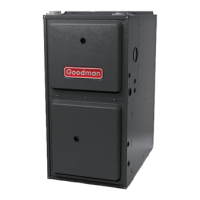8
6. Follow the lighting instructions. Place the appliance
being inspected in operation. Adjust thermostat so
appliance shall operate continuously.
7. Test for spillage from draft hood appliances at the
draft hood relief opening after 5 minutes of main
burner operation. Use the ame of a match or candle.
8. If improper venting is observed during any of the
above tests, the venting system must be corrected in
accordance with the National Fuel Gas Code ANSI
Z223.1/NFPA 54 and/or National Gas and Propane
Installation Code CAN/CSA B149.1-15.
9. After it has been determined that each appliance
connected to the venting system properly vents when
tested as outlined above, return doors, windows,
exhaust fans, replace dampers and any other gas
burning appliance to their previous conditions of use.
If resizing is required on any portion of the venting system,
use the appropriate table in Appendix G in the latest edition
of the National Fuel Gas Code ANSI Z223.1 and/or CAN/
CSA B149.1-15 Installation Codes.
WARNING
Improved construction and additional insulation in buildings
have reduced heat loss by reducing air inltration and
escape around doors and windows. These changes have
helped in reducing heating/cooling costs but have created
a problem supplying combustion and ventilation air for
gas red and other fuel burning appliances. Appliances
that pull air out of the house (clothes dryers, exhaust
fans, replaces, etc.) increase the problem by starving
appliances for air.
House depressurization can cause back drafting or
improper combustion of gas-red appliances, thereby
exposing building occupants to gas combustion products
that could include carbon monoxide.
If this furnace is to be installed in the same space with
other gas appliances, such as a water heater, ensure there
is an adequate supply of combustion and ventilation air
for the other appliances. Refer to the latest edition of the
National Fuel Gas Code NFPA 54/ANSI Z223.1 or CAN/
CSA B149.1-15 Installation Codes or applicable provisions
of the local building codes for determining the combustion
air requirements for the appliances.
Clearance in accordance with local installation codes, the
requirements of the gas supplier and the manufacturer’s
installation instructions.
Dégaugement conforme aux dodes d’installation locaux,
aux exigences du fournisseur de gaz et aux instructions
d’installation du fabricant.
A furnace installed in a conned space (i.e., a closet or
utility room) must have two ventilation openings with a
total minimum free area of 0.25 square inches per 1,000
BTU/hr of furnace input rating. Refer to Specication
Sheet applicable to your model for minimum clearances
to combustible surfaces. One of the ventilation openings
must be within 12 inches of the top; the other opening must
be within 12 inches of the bottom of the conned space. In
a typical construction, the clearance between the door and
door frame is usually adequate to satisfy this ventilation
requirement.
The following vent testing procedure is repro duced from
the
The following steps shall be followed with each appliance
connected to the venting system placed in operation, while
any other appliances connected to the venting system are
not in operation:
1. Seal any unused openings in the venting system.
2. Inspect the venting system for proper size and
horizontal pitch, as required by the National Fuel Gas
Code, ANSI Z223.1 or the Natural Gas and Propane
Installation Code, CAN/CSA B149.1-15 and these
instructions. Determine that there is no blockage or
restriction, leakage, corrosion and other deciencies
which could cause an unsafe condition.
3. As far as practical, close all building doors and
windows and all doors between the space in which
the appliance(s) connected to the venting system are
located and other spaces of the building.
4. Close replace dampers.
5. Turn on clothes dryers and any appliance not
connected to the venting system. Turn on any exhaust
fans, such as range hoods and bathroom exhausts,
so they shall operate at maximum speed. Do not
operate a summer exhaust fan.

